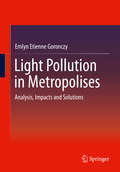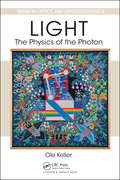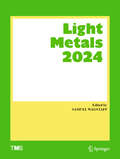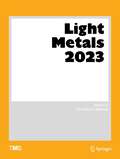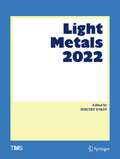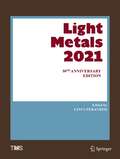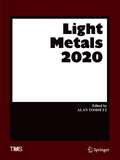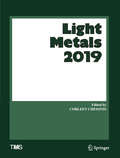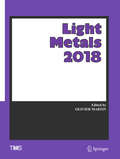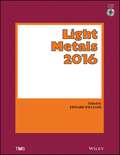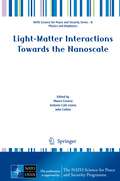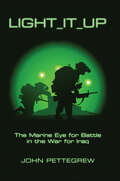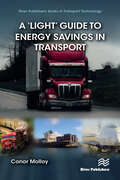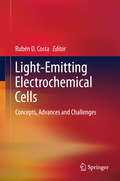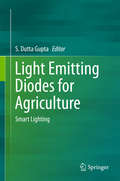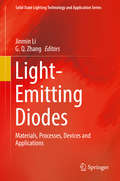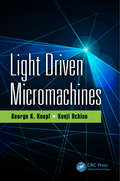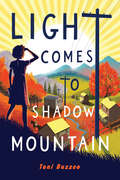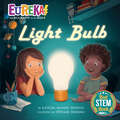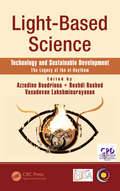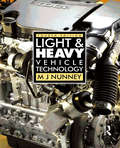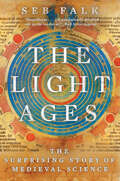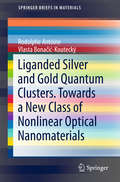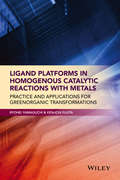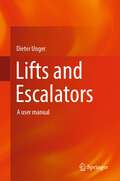- Table View
- List View
Light Pollution in Metropolises: Analysis, Impacts and Solutions
by Emlyn Etienne GoronczyLight pollution (light smog, light pollution or light emissions) is a fundamental problem in metropolises with effects on flora, fauna and people. Accordingly, the first section of the book discusses the basics of light pollution and its effects on various organisms. The characteristics of light smog in the cities of Hanover, Warsaw, Boston, New York City and Toronto are then analysed and compared. But how can the problem be tackled? Existing measures for the prevention of light pollution are discussed and further novel approaches are shown by comparing the metropolises. The book is aimed primarily at practitioners in this field and helps to identify sources of emissions and identify suitable reduction measures. This book is a translation of the original German edition „Lichtverschmutzung in Metropolen“ by Emlyn Etienne Goronczy, published by Springer Fachmedien Wiesbaden GmbH in 2018. The translation was done with the help of artificial intelligence (machine translation by the service DeepL.com). A subsequent human revision was done primarily in terms of content, so that the book will read stylistically differently from a conventional translation. Springer Nature works continuously to further the development of tools for the production of books and on the related technologies to support the authors.
Light - The Physics of the Photon (Series in Optics and Optoelectronics)
by Ole KellerFrom the early wave-particle arguments to the mathematical theory of electromagnetism to Einstein's work on the quantization of light, different descriptions of what constitutes light have existed for over 300 years. Light - The Physics of the Photon examines the photon phenomenon from several perspectives. It demonstrates the importance of studyin
Light Metals 2024 (The Minerals, Metals & Materials Series)
by Samuel WagstaffThe Light Metals symposia at the TMS Annual Meeting & Exhibition present the most recent developments, discoveries, and practices in primary aluminum science and technology. The annual Light Metals volume has become the definitive reference in the field of aluminum production and related light metal technologies. The 2024 collection includes contributions from the following symposia: · Alumina & Bauxite · Aluminum Alloys: Development and Manufacturing · Aluminum Reduction Technology · Electrode Technology for Aluminum Production · Melt Processing, Casting and Recycling · Scandium Extraction and Use in Aluminum Alloys
Light Metals 2023 (The Minerals, Metals & Materials Series)
by Stephan BroekThe Light Metals symposia at the TMS Annual Meeting & Exhibition present the most recent developments, discoveries, and practices in primary aluminum science and technology. The annual Light Metals volume has become the definitive reference in the field of aluminum production and related light metal technologies. The 2023 collection includes contributions from the following symposia: · 60 Years of Taking Aluminum Smelting Research and Development from New Zealand to the World: An LMD Symposium in Honor of Barry J. Welch · Alumina & Bauxite · Aluminium Industry Emissions Measurement, Reporting & Reduction · Aluminium Waste Management & Utilisation · Aluminum Alloys, Characterization and Processing · Aluminum Reduction Technology · Cast Shop Technology · Electrode Technology for Aluminum Production · Scandium Extraction and Use in Aluminum Alloys
Light Metals 2022 (The Minerals, Metals & Materials Series)
by Dmitry EskinThe Light Metals symposia at the TMS Annual Meeting & Exhibition present the most recent developments, discoveries, and practices in primary aluminum science and technology. The annual Light Metals volume has become the definitive reference in the field of aluminum production and related light metal technologies. The 2022 collection includes contributions from the following symposia: • Alumina and Bauxite • Aluminum Alloys, Processing and Characterization • Aluminum Reduction Technology • Aluminum Reduction Technology Joint Session with REWAS: Decarbonizing the Metals Industry • Cast Shop Technology • Electrode Technology for Aluminum Production • Primary Aluminum Industry—Energy and Emission Reductions: An LMD Symposium in Honor of Halvor Kvande • Recycling and Sustainability in Cast Shop Technology: Joint Session with REWAS 2022
Light Metals 2021: 50th Anniversary Edition (The Minerals, Metals & Materials Series)
by Linus PeranderThe Light Metals symposia at the TMS Annual Meeting & Exhibition present the most recent developments, discoveries, and practices in primary aluminum science and technology. The annual Light Metals volume has become the definitive reference in the field of aluminum production and related light metal technologies. The 2021 collection includes contributions from the following symposia: · Alumina and Bauxite · Aluminum Alloys, Processing, and Characterization · Aluminum Reduction Technology · Aluminum Reduction Technology Across the Decades: An LMD Symposium Honoring Alton T. Tabereaux, Halvor Kvande and Harald A. Øye · Cast Shop Technology · Electrode Technology for Aluminum Production
Light Metals 2020 (The Minerals, Metals & Materials Series)
by Alan TomsettThe Light Metals symposia at the TMS Annual Meeting & Exhibition present the most recent developments, discoveries, and practices in primary aluminum science and technology. The annual Light Metals volume has become the definitive reference in the field of aluminum production and related light metal technologies. The 2020 collection includes papers from the following symposia: • Alumina and Bauxite• Aluminum Alloys, Processing and Characterization• Aluminum Reduction Technology• Cast Shop Technology• Cast Shop Technology: Recycling and Sustainability Joint Session• Electrode Technology for Aluminum Production
Light Metals 2019 (The Minerals, Metals & Materials Series)
by Corleen ChesonisThe Light Metals symposia at the TMS Annual Meeting & Exhibition present the most recent developments, discoveries, and practices in primary aluminum science and technology. The annual Light Metals volume has become the definitive reference in the field of aluminum production and related light metal technologies. The 2019 collection includes papers from the following symposia: 1. Alumina and Bauxite 2. Aluminum Alloys, Processing, and Characterization 3. Aluminum Reduction Technology 4. Cast Shop Technology 5. Cast Shop Technology: Energy Joint Session 6. DGM-TMS Symposium on Lightweight Metals 7. Electrode Technology for Aluminum Production 8. REWAS 2019: Cast Shop Recycling Technologies 9. Scandium Extraction and Use in Aluminum Alloys 10. Ultrasonic Processing of Liquid and Solidifying Alloys
Light Metals 2018 (The Minerals, Metals & Materials Series)
by Olivier MartinThe Light Metals symposia at the TMS Annual Meeting & Exhibition present the most recent developments, discoveries, and practices in primary aluminum science and technology. The annual Light Metals volume has become the definitive reference in the field of aluminum production and related light metal technologies. The 2018 collection includes papers from the following symposia: 1. Alumina and Bauxite 2. Aluminum Alloys, Processing, and Characterization 3. Aluminum Reduction Technology 4. Cast Shop Technology 5. Cast Shop Technology: Energy Joint Session 6. Cast Shop Technology: Fundamentals of Aluminum Alloy Solidification Joint Session 7. Cast Shop Technology: Recycling and Sustainability Joint Session 8. Electrode Technology for Aluminum Production 9. Perfluorocarbon Generation and Emissions from Industrial Processes 10. Scandium Extraction and Use in Aluminum Alloys
Light Metals 2016
by The Minerals, Metals & Materials SocietyThe 2016 collection will include papers from the following symposia: Alumina and Bauxite Aluminum Alloys, Processing, and Characterization Aluminum Reduction Technology Cast Shop Technology Electrode Technology Strip Casting
Light-Matter Interactions Towards the Nanoscale (NATO Science for Peace and Security Series B: Physics and Biophysics)
by Maura Cesaria Antonio Calà Lesina John CollinsThe investigation of light-matter interactions in materials, especially those on the nanoscale, represents perhaps the most promising avenue for scientific progress in the fields of photonics and plasmonics. This book examines a variety of topics, starting from fundamental principles, leading to the current state of the art research. For example, this volume includes a chapter on the sensing of biological molecules with optical resonators (microspheres) combined with plasmonic systems, where the response this system are described in a fundamental and elegant manner using coupled mode theory. Symmetry plays a major role in the book. One chapter on time reversal symmetry in electromagnetic theory describes how to control the properties of light (e.g. scattering and directionality of the flow of light) in materials with certain topological invariants. Another chapter where symmetry is prominent reformulates, using a gentle and pedagogical approach, Maxwell’s Equations into a new set of fields that reveal a “handedness” symmetry in electromagnetic theory, which can be applied to photonic systems in, for example, the sensing of chiral molecules and understanding the conditions for zero reflection. Also, for students and researchers starting in the field of nanoplasmonics, the book includes a tutorial on the finite element time domain simulation of nanoplasmonic systems. Other topics include photonic systems for quantum computing, nanoplasmonics, and optical properties of nano and bulk materials. The authors take a pedagogical approach to their topic, making the book an excellent reference for graduate students and scientists starting in the fields of photonics or plasmonics.
Light It Up: The Marine Eye for Battle in the War for Iraq
by John PettegrewExamines the U.S. Marines’ visual culture of combat in the Iraq War.American military power in the War on Terror has increasingly depended on the capacity to see the enemy. The act of seeing—enhanced by electronic and digital technologies—has separated shooter from target, eliminating risk of bodily harm to the remote warrior, while YouTube videos eroticize pulling the trigger and video games blur the line between simulated play and fighting.Light It Up examines the visual culture of the early twenty-first century military. Focusing on the Marine Corps, which played a critical part in the invasion and occupation of Iraq, John Pettegrew argues that U.S. military force in the Iraq War was projected through an "optics of combat." Powerful military technology developed in the Iraq and Afghanistan wars has placed war in a new posthuman era.Pettegrew’s interviews with marines, as well as his analysis of first-person shooter videogames and combat footage, lead to startling insights into the militarization of popular digital culture. An essential study for readers interested in modern warfare, policy makers, and historians of technology, war, and visual and military culture.
A ‘Light’ Guide to Energy Savings in Transport
by Conor MolloyThis book is a practical guide to finding and delivering energy savings opportunities in transport operations for professional energy managers and energy auditors. Globally, transport is one of the fastest growing energy consumers and emitters of greenhouse gases, predominantly CO2. The transport sector is also changing quickly ("more change in the last 5 years than in the last 50" – Mary Barra, CEO General Motors). After distance, unladen vehicle weight is the biggest driver of energy consumption in transport, hence this book is called the ‘light’ guide – tongue in cheek. Be warned transport is a huge and complex topic. This practical guide from the convener of EN16247-4:2014, the first European energy audit standard for transport, takes a pragmatic approach to delivering measurable energy and emissions reductions in transport operations. Lessons learnt from the author’s 17 years of experience in persuading operators to deliver measured energy savings in transport are interwoven with tools, tips and shortcuts. These will help energy managers and auditors deliver effective transport energy audits that identify opportunities, prompting action, measured savings and, most importantly, being invited back!
Light-Emitting Electrochemical Cells
by Rubén D. CostaThis book presents the recent achievements towards the next generation of Light-emitting electrochemical cells (LEC). Its first part focus on the definition, history and mechanism of LEC, going then to concepts and challenges and, finally, giving the reader examples of current application of new electroluminescent materials. The chapters are written by different international groups working on LEC.
Light Emitting Diodes for Agriculture
by S Dutta GuptaThis book presents a comprehensive treatise on the advances in the use of light-emitting diodes (LEDs) for sustainable crop production and describes the latest photomorphogenesis research findings. It introduces readers to the fundamentals and design features of LEDs applicable for plant growth and development and illustrates their advantages over the traditional lighting systems, including cost analyses. Further, it discusses a wide range of applications covering diverse areas of plant sciences relevant to controlled environment agriculture and in vitro plant morphogenesis. The chapters have been written by a team of pioneering international experts, who have made significant contributions to this emerging interdisciplinary field. The book will serve a valuable resource for graduate students, instructors, and researchers in the fields of horticulture, agricultural biotechnology, cell and developmental biology, and precision agriculture. It will also serve well profe ssionals engaged in greenhouse and vertical farming.
Light-Emitting Diodes: Materials, Processes, Devices and Applications (Solid State Lighting Technology and Application Series #4)
by Jinmin Li G. Q. ZhangComprehensive in scope, this book covers the latest progresses of theories, technologies and applications of LEDs based on III-V semiconductor materials, such as basic material physics, key device issues (homoepitaxy and heteroepitaxy of the materials on different substrates, quantum efficiency and novel structures, and more), packaging, and system integration. The authors describe the latest developments of LEDs with spectra coverage from ultra-violet (UV) to the entire visible light wavelength. The major aspects of LEDs, such as material growth, chip structure, packaging, and reliability are covered, as well as emerging and novel applications beyond the general and conventional lightings. This book, written by leading authorities in the field, is indispensable reading for researchers and students working with semiconductors, optoelectronics, and optics. Addresses novel LED applications such as LEDs for healthcare and wellbeing, horticulture, and animal breeding; Editor and chapter authors are global leading experts from the scientific and industry communities, and their latest research findings and achievements are included; Foreword by Hiroshi Amano, one of the 2014 winners of the Nobel Prize in Physics for his work on light-emitting diodes.
Light Driven Micromachines
by George K. Knopf Kenji UchinoIn Light Driven Micromachines, the fundamental principles and unique characteristics of light driven material structures, simple mechanisms and integrated machines are explored. Very small light driven systems provide a number of interesting features and unique design opportunities because streams of photons deliver energy into the system and provide the control signal used to regulate the response of the micron sized device. Through innovative material design and clever component fabrication, these optically powered tiny machines can be created to perform mechanical work when exposed to varying light intensity, wavelength, phase, and/or polarization. The book begins with the scientific background necessary to understand the nature of light and how light can initiate physical movement by inducing material deformation or altering the surrounding environment to impose micro-forces on the actuating mechanisms. The impact of physical size on the performance of light driven mechanisms and machines is discussed, and the nature of light–material interactions is reviewed. These interactions enable very small objects and mechanical components to be trapped and manipulated by a focused light beam, or produce local temperature gradients that force certain materials to undergo shape transformation. Advanced phase transition gels, polymers, carbon-based films and piezoelectric ceramics that exhibit direct light-to-mechanical energy conversion are examined from the perspective of designing optically driven actuators and mechanical systems. The ability of light to create photothermal effects that drive microfluidic processes and initiate the phase transformation of temperature sensitive shape memory materials are also explored in the book. This compendium seeks to inspire the next generation of scientists and engineers by presenting the fundamental principles of this emerging interdisciplinary technology and exploring how the properties of light can be exploited for microfluidic, microrobotic, biomedical and space applications.
Light Comes to Shadow Mountain
by Toni BuzzeoCora Mae Tipton is determined to light up her Appalachian community in this historical fiction novel from an award-winning author and former librarian.It&’s 1937 and the government is pushing to bring electricity to the mountains of southeastern Kentucky. It&’s all Cora can think of; radios with news from around the world, machines that keep food cold, lightbulbs by which to read at night! Cora figures she can help spread the word by starting a school newspaper and convincing her neighbors to support the Rural Electrification Act.But resistance to change isn&’t easy to overcome, especially when it starts at home. Cora&’s mother is a fierce opponent of electrification. She argues that protecting the landscape of the holler—the trees, the streams, the land that provides for their way of life—is their responsibility. But Cora just can&’t let go of wanting more. Lyrical, literary, and deeply heartfelt, this debut novel from an award-winning author-librarian speaks to family, friendship, and loss through the spirited perspective of a girl eager for an electrified existence, but most of all, the light of her mother&’s love and acceptance.Back matter includes an Author&’s Note; further information on the Rural Electrification Act, the herbs and plants of Appalachia, the Pack Horse Library Project, and more; and a &“Quick Questions&” historical trivia section for readers.A Junior Library Guild Gold Standard Selection
Light Bulb: Eureka! The Biography of an Idea (Eureka! The Biography of an Idea)
by Kathleen Weidner ZoehfeldElectric lights--without them, we'd be in the dark! Here is a "biography" of the light bulb, an essential invention that lights up our days and nights.From the first spark of Thomas Alva Edison's idea to the spread of electric lights around the world, Light Bulb is a fun and informative look at an invention that makes a huge difference in our lives. This STEAM nonfiction title is part of the new Eureka! series, each book covering one groundbreaking, world-changing discovery that millions of people use every single day.
Light-Based Science: Technology and Sustainable Development, The Legacy of Ibn al-Haytham
by Azzedine Boudrioua Roshdi Rashed Vasudevan LakshminarayananThis book discusses light-based science, emphasizing its pervasive influence in science, technology, policy, and education. A wide range of contributors offers a comprehensive study of the tremendous, and indeed foundational, contributions of Ibn al Haytham, a scholar from the medieval period. The analysis then moves into the future development of light-based technology. Written as a multi-disciplinary reference book by leading scholars in the history of science and /or photonics, it covers Ibn al Haytham’s optics, LED lighting for sustainable development, global and atomic-scale time with new light sources, advanced technology, and vision science. Cutting-edge optical technologies and their global impact is addressed in detail, and the later chapters also explore challenges with renewable energy, the global impact of photonics, and optical and photonic education technology. Practical examples and illustrations are provided throughout the text.
Light and Heavy Vehicle Technology
by M J NunneyLight and Heavy Vehicle Technology, Fourth Edition, provides a complete text and reference to the design, construction and operation of the many and varied components of modern motor vehicles, including the knowledge needed to service and repair them. This book provides incomparable coverage of both cars and heavier vehicles, featuring over 1000 illustrations.This new edition has been brought fully up to date with modern practices and designs, whilst maintaining the information needed to deal with older vehicles. Two entirely new sections of the book provide a topical introduction to alternative power sources and fuels, and battery-electric, hybrid and fuel-cell vehicles. More information on the latest developments in fuel injection, diesel engines and transmissions has also been added. An expanded list of technical abbreviations now contains over 200 entries – a useful resource for professional technicians in their day-to-day work.This book is an essential textbook for all students of automotive engineering, particularly on IMI / C&G 4000 series and BTEC courses and provides all the underpinning knowledge required for NVQs to level 3. By bridging the gap between basic and more advanced treatments of the subject, it also acts as a useful source of information for experienced technicians and technically minded motorists, and will help them to improve their knowledge and skills.
The Light Ages: The Surprising Story Of Medieval Science
by Seb FalkAn illuminating guide to the scientific and technological achievements of the Middle Ages through the life of a crusading astronomer-monk. Soaring Gothic cathedrals, violent crusades, the Black Death: these are the dramatic forces that shaped the medieval era. But the so-called Dark Ages also gave us the first universities, eyeglasses, and mechanical clocks. As medieval thinkers sought to understand the world around them, from the passing of the seasons to the stars in the sky, they came to develop a vibrant scientific culture. In The Light Ages, Cambridge science historian Seb Falk takes us on a tour of medieval science through the eyes of one fourteenth-century monk, John of Westwyk. Born in a rural manor, educated in England’s grandest monastery, and then exiled to a clifftop priory, Westwyk was an intrepid crusader, inventor, and astrologer. From multiplying Roman numerals to navigating by the stars, curing disease, and telling time with an ancient astrolabe, we learn emerging science alongside Westwyk and travel with him through the length and breadth of England and beyond its shores. On our way, we encounter a remarkable cast of characters: the clock-building English abbot with leprosy, the French craftsman-turned-spy, and the Persian polymath who founded the world’s most advanced observatory. The Light Ages offers a gripping story of the struggles and successes of an ordinary man in a precarious world and conjures a vivid picture of medieval life as we have never seen it before. An enlightening history that argues that these times weren’t so dark after all, The Light Ages shows how medieval ideas continue to color how we see the world today.
Liganded silver and gold quantum clusters. Towards a new class of nonlinear optical nanomaterials (SpringerBriefs in Materials)
by Vlasta Bonačić-Koutecký Rodolphe AntoineMetallic quantum clusters belonging to intermediate size regime between two and few hundred of atoms, represent unique building blocks of new materials. Nonlinear optical (NLO) characteristics of liganded silver and gold quantum clusters reveal remarkable features which can be tuned by size, structure and composition. The two-photon absorption cross sections of liganded noble metal quantum clusters are several orders of magnitude larger than that of commercially-available dyes. Therefore, the fundamental photophysical understanding of those two-photon processes in liganded clusters with few metal atoms deserve special attention, in particularly in context of finding the mechanisms responsible for these properties. A broad range of state-of-the-art experimental methods to determine nonlinear optical properties (i.e. two-photon absorption, two-photon excited fluorescence and second harmonic generation) of quantum clusters are presented. The experimental setup and underlying physical concepts are described. Furthermore, the theoretical models and corresponding approaches are used allowing to explain the experimental observations and simultaneously offering the possibility to deduce the key factors necessary to design new classes of nanoclusters with large NLO properties. Additionally, selected studied cases of liganded silver and gold quantum clusters with focus on their NLO properties will be presented as promising candidates for applications in imaging techniques such as fluorescence microscopy or Second-Harmonic Generation microscopy.
Ligand Platforms in Homogenous Catalytic Reactions with Metals: Practice and Applications for Green Organic Transformations
by Ryohei Yamaguchi Ken-ichi FujitaServing as a user's manual for synthetic organic and catalytic chemists, this book guides chemists in the design and choice of ligands to catalyze organic reactions and apply the results for more efficient, green, and practical synthesis. • Focuses on the role of ligands in metal complexes that catalyze green organic transformations: a hot topic in the area of organic synthesis and green chemistry • Offers a comprehensive resource to help readers design and choose ligands and understand selectivity/reactivity characteristics • Addresses a gap by taking novel ligand approaches and including up-to-date discussion on hydrogen transfers and reactions • Presents important industrial perspective and provides rational explanations of ligand effects, impacts, and novelty
Lifts and Escalators: A user manual
by Dieter UngerThis book offers everyone who plans, builds or operates lifts and escalators a comprehensive overview of the important topics: starting with the standards and technical rules through to the history of technology. Planning, operation, maintenance and documentation of lifts and escalators are described. Numerous meaningful color illustrations complement the text. The book serves as a reference work for operators of lifts and escalators. The many examples, tips and advice from practice make it a helpful companion in daily work.
